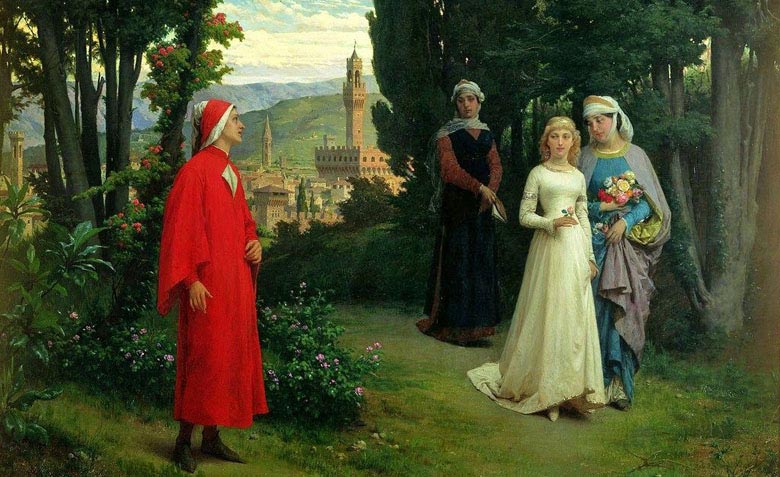 Henry Holiday: First Meeting of Dante and Beatrice (1877) - Image posted by Victorian British Painting
Henry Holiday: First Meeting of Dante and Beatrice (1877) - Image posted by Victorian British Painting
Florence is a city incredibly rich in history and charm. Its beauty and the vibrant ferment that has always animated it have inspired entire generations of poets, architects, musicians, sculptors and painters. But what do we know about the women who have populated it and their fundamental contribution in making it that precious treasure chest of culture and art that we all know?
Among the best known, there is undoubtedly the famous Bice Portinari, Dante’s Beatrice, to whom the Supreme Poet dedicated verses and "sweet" rhymes, represented as a frigid and angelic woman, in full stilnovo register. Daughter of Folco Portinari and wife of Simone de' Bardi, Beatrice died during childbirth at a young age, but her historic figure remains indelible in the history of Italian literature, thanks to Dante’s "Vita nova" and “Commedia”.
Another Florentine woman of absolute depth was Anna Maria Luisa, the last representative of the Medici family. Known as "l'Elettrice Palatina", she left the vast family art collection in the Tuscan state, inherited in turn in 1737 by her brother Gian Gastone, the last grand duke of the family. It is in her honor that every year on February 18th, on the anniversary of her death, the Musei Civici Fiorentini can be visited for free.
But that is not all! The history of Italian art is, in fact, studded with incomparable portraits of "Madonnas": from Filippo Lippi to Raffaello Sanzio, up to Botticelli. And the latter has made immortal a woman of such beauty as to remain unchanged over the centuries. This woman is Simonetta Cattaneo Vespucci, sister-in-law of the navigator Amerigo and immortalized as Venus and Spring in the wonderful Botticellian frescoes.
A woman, on the other hand, "on the other side of the canvas" was Artemisia Gentileschi, painter, innovator and great pioneer in art history. Daughter of the Pisan painter Orazio Gentileschi, she moved to Florence after marrying Pierantonio Stiattesi. Her portraits in Caravaggio style, of the "Maddalena" and of "Giuditta and Oloferne" are exhibited in the Uffizi Gallery.
From art history to science, in a decidedly more modern era: the great Margherita Hack, a true Florentine, was among those women who helped make Florence a true epicenter of culture. Astrophysicist and the first Italian woman Director of the Astronomical Observatory of Trieste, she perfectly embodied the ideal of the free and unconventional woman, combining a great and exemplary social commitment to the incessant life of scientific research.
These are just some of the many Florentine women of the past and present to be inspired by and take an example from. We'll explore this in the new section "Florentine Madonnas" on our blog! Don’t miss it!



